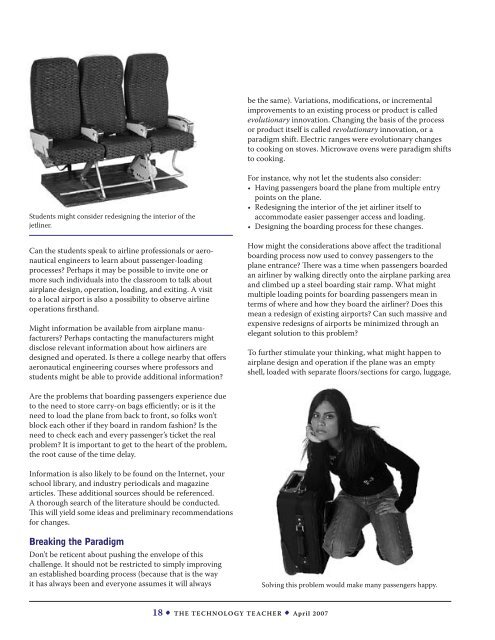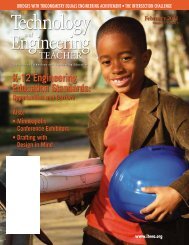Vol 66, No. 7 - International Technology and Engineering Educators ...
Vol 66, No. 7 - International Technology and Engineering Educators ...
Vol 66, No. 7 - International Technology and Engineering Educators ...
Create successful ePaper yourself
Turn your PDF publications into a flip-book with our unique Google optimized e-Paper software.
e the same). Variations, modifications, or incremental<br />
improvements to an existing process or product is called<br />
evolutionary innovation. Changing the basis of the process<br />
or product itself is called revolutionary innovation, or a<br />
paradigm shift. Electric ranges were evolutionary changes<br />
to cooking on stoves. Microwave ovens were paradigm shifts<br />
to cooking.<br />
Students might consider redesigning the interior of the<br />
jetliner.<br />
Can the students speak to airline professionals or aeronautical<br />
engineers to learn about passenger-loading<br />
processes? Perhaps it may be possible to invite one or<br />
more such individuals into the classroom to talk about<br />
airplane design, operation, loading, <strong>and</strong> exiting. A visit<br />
to a local airport is also a possibility to observe airline<br />
operations firsth<strong>and</strong>.<br />
Might information be available from airplane manufacturers?<br />
Perhaps contacting the manufacturers might<br />
disclose relevant information about how airliners are<br />
designed <strong>and</strong> operated. Is there a college nearby that offers<br />
aeronautical engineering courses where professors <strong>and</strong><br />
students might be able to provide additional information?<br />
For instance, why not let the students also consider:<br />
• Having passengers board the plane from multiple entry<br />
points on the plane.<br />
• Redesigning the interior of the jet airliner itself to<br />
accommodate easier passenger access <strong>and</strong> loading.<br />
• Designing the boarding process for these changes.<br />
How might the considerations above affect the traditional<br />
boarding process now used to convey passengers to the<br />
plane entrance? There was a time when passengers boarded<br />
an airliner by walking directly onto the airplane parking area<br />
<strong>and</strong> climbed up a steel boarding stair ramp. What might<br />
multiple loading points for boarding passengers mean in<br />
terms of where <strong>and</strong> how they board the airliner? Does this<br />
mean a redesign of existing airports? Can such massive <strong>and</strong><br />
expensive redesigns of airports be minimized through an<br />
elegant solution to this problem?<br />
To further stimulate your thinking, what might happen to<br />
airplane design <strong>and</strong> operation if the plane was an empty<br />
shell, loaded with separate floors/sections for cargo, luggage,<br />
Are the problems that boarding passengers experience due<br />
to the need to store carry-on bags efficiently; or is it the<br />
need to load the plane from back to front, so folks won’t<br />
block each other if they board in r<strong>and</strong>om fashion? Is the<br />
need to check each <strong>and</strong> every passenger’s ticket the real<br />
problem? It is important to get to the heart of the problem,<br />
the root cause of the time delay.<br />
Information is also likely to be found on the Internet, your<br />
school library, <strong>and</strong> industry periodicals <strong>and</strong> magazine<br />
articles. These additional sources should be referenced.<br />
A thorough search of the literature should be conducted.<br />
This will yield some ideas <strong>and</strong> preliminary recommendations<br />
for changes.<br />
Breaking the Paradigm<br />
Don’t be reticent about pushing the envelope of this<br />
challenge. It should not be restricted to simply improving<br />
an established boarding process (because that is the way<br />
it has always been <strong>and</strong> everyone assumes it will always<br />
Solving this problem would make many passengers happy.<br />
18 • The <strong>Technology</strong> Teacher • April 2007
















